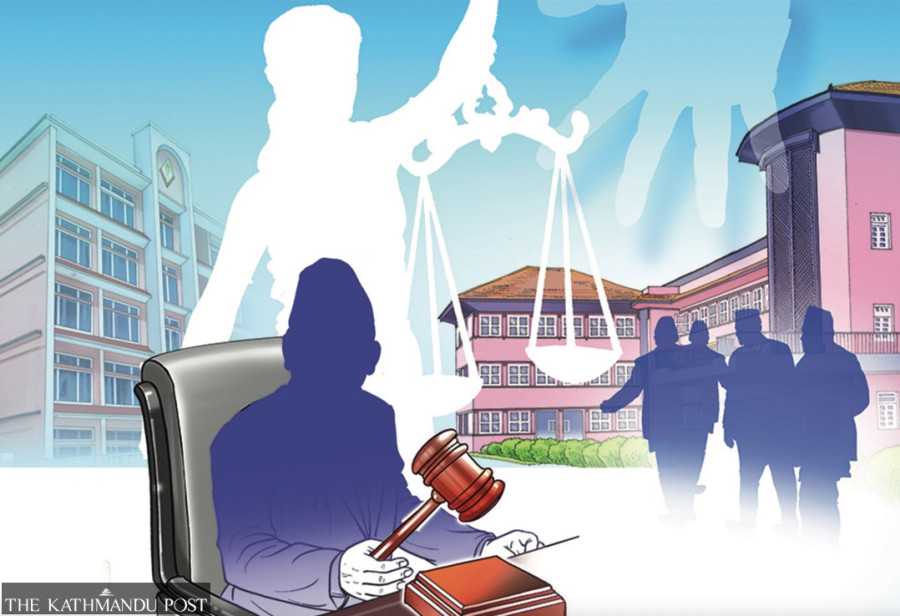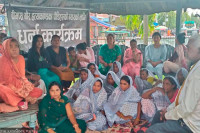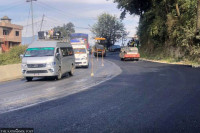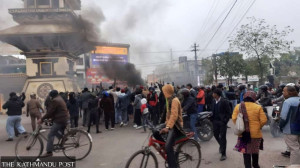National
Nepal’s judiciary is plagued by systemic problems
Current crisis in Supreme Court has been in the making for years and is a result of bad precedents, political meddling and flawed appointment process, observers say.
Binod Ghimire
The judiciary and the legal fraternity have turned against Chief Justice Cholendra Shumsher Rana. Supreme Court justices, former justices and lawyers—from Nepal Bar Association and Supreme Court Bar Association—have joined the chorus to demand Rana’s resignation.
They have accused Rana of demanding a share in Cabinet and constitutional bodies, failing to maintain judicial integrity and passing controversial verdicts. They say Rana failed to lead, clean up the mess in the judiciary and attempted to cause irreparable damage to the judiciary.
Rana, however, has refused to budge. On Tuesday, he rejected calls for his resignation. A judicial deadlock is on the cards. The longer the crisis continues, the more the judiciary’s image will be tarnished.
Observers, legal experts and former justices, however, say the crisis in Nepal’s judiciary was in the making for quite a while and Rana’s resignation alone may not be the panacea for all ills afflicting the country’s Supreme Court. And this is not the first time a chief justice has run into controversy.
Barring a few, particularly those who had pretty short tenures, there has not been one chief justice in Nepal who has not had a brush with controversies in the last one decade.
“There were some problems before also but there was a sudden rise in anomalies in the judiciary after 2006,” Prakash Osti, a former Supreme Court justice, told the Post.
Rana succeeded Om Prakash Mishra, who had a very short tenure of five months. Mishra was appointed chief justice after Deepak Raj Joshee failed to get through the parliamentary hearing.
During his tenure as acting chief justice from March to August 2018, questions were raised over Joshee’s academic credentials, controversial verdicts and capability to lead the judiciary. The Parliamentary Hearing Committee on August 2, 2018 rejected his recommendation as the chief justice on the ground that he had failed to maintain integrity.
His predecessor Gopal Parajuli also faced serious allegations regarding his age and academic credentials and controversial verdicts. The Post’s sister paper Kantipur faced a contempt of court charge for a series of reports on Parajuli. On March 12, 2018 when Parajuli called a full bench to hear the contempt case against the Kantipur newspaper, Rana who then was a Supreme Court justice, boycotted. In an unprecedented move, the Judicial Council in March 2018 handed over a termination letter to Parajuli, saying he had already crossed his age bar to remain in the post.
Coincidentally, Rana faced a similar boycott by as many as 13 justices on Monday. The justices refused to attend a full court meeting called by Rana.
Sushila Karki, who preceded Parajuli, is considered to be fair in her decision-making process. However, even she could not skip controversies.
Over her decision to quash a government decision to appoint Jaya Bahadur Chand as the chief of Nepal Police, the Nepali Congress and the Communist Party of Nepal (Maoist Centre) in April 2017 registered an impeachment motion against her. The Congress and the Maoist Centre led a coalition government then.
The Supreme Court, however, stayed the impeachment motion. And the bench that passed the ruling staying the motion was led by Rana.
“Rana’s controversies might have been higher in degree and intensity, but almost every chief justice has faced controversies in the past,” said Osti.
Nepal’s chief justices running into controversies puts a spotlight on the deep-rooted problems, and many say time has come to move on from witch-hunting to finding the systemic issues that have plagued the judiciary.
Former justices say the problem starts with the appointment process.
“There has been a naked intervention of the political parties while appointing justices,” said Osti.
Except chief justice, all justices and judges are recommended by the Judicial Council (JC).
The JC has been in place since 1990, after the restoration of democracy. Its composition, however, was changed after the interim constitution 2007 came into effect.
Before the 2007 constitution, the JC used to have the chief justice as the ex-officio chairperson and two senior justices and a jurist appointed by the king as members and the minister for law and justice as an ex-officio member. In the five-member council, non-political actors had a majority.
However, its composition was changed after 2007. A senior-most justice, an advocate each picked by the government and Nepal Bar Association and minister for law and justice were included as members in the JC led by the chief justice. The same composition got continuity when the new constitution was adopted in 2015.
Law minister and two members recommended by the government and Nepal Bar, who have political affiliations, now control a majority in the five-member council.
Justices over the years have been appointed on the basis of their political affiliations. Observers say justices who are supposed to impart justice started serving their political masters.
Judges Society of Nepal, an association of incumbent and retired judges and justices, said on Tuesday that the problem in the judiciary is not going to end unless political interference ends.
Issuing a statement, the society, led by Ishwar Prasad Katiwada, said political sharing in the judiciary in coordination with the Judicial Council is responsible for the present anomalies. Time has come to launch a campaign to end political interference in the judiciary, it said.
“There is a systemic problem in the judiciary which needs to be fixed,” Baburam Regmi, vice-chairperson of the Society, told the Post. “Change in the judiciary is not possible until the kith and kin of those in power and party cadres continue to get appointed as judges.”
Rana, who was an advocate, became an Appellate Court judge in 1997. From January 2006 to September 2008, Rana also served as a member of the Special Court, which is instituted to deal with corruption cases. His decisions as an appellate court judge and a member of the Special Court, however, had courted controversy in the past too. Some of his decisions to acquire the corruption accused were overturned by the Supreme Court.
However, in 2014, the Judicial Council led by then chief justice Damodar Sharma recommended Rana, Parajuli and Joshee as Supreme Court justices, while refusing to give continuity to Justices Osti and Bharat Raj Uprety, who were considered competent and fair. Since Osti and Uprety were not permanent justices, they had to leave after Rana, Parajuli and Joshee were recommended.
Narahari Acharya, a Nepali Congress leader, was the ex-officio member of the Judicial Council in the capacity of law minister. Those familiar with the development then and those who have closely followed the judiciary and appointments say the recommendations were made at the behest of Acharya.
Rana was recommended for the post of chief justice on December 13, 2018 by the Constitutional Council, which was then chaired by KP Sharma Oli who was elected prime minister in February that year. The Parliamentary Hearing Committee had received as many as nine complaints against him over his rulings. His name, however, was endorsed by the hearing committee for the post of chief justice and he took the helm of the judiciary on January 2, 2019.
“You cannot expect the judiciary to perform professionally when you choose a wrong person to lead it,” senior advocate Dinesh Tripathi, chairperson of the Constitutional Lawyers’ Forum, told the Post. “You reap what you sow.”
In 2013, there was an incident when around a dozen appellate court judges had reached the CPN-UML headquarters in Balkhu to express their gratitude to the party for recommending them.
Those who have closely followed Nepal’s legal system say appointment of then sitting chief justice Khil Raj Regmi as chairperson of the Council of Ministers in 2013 was yet another incident that dealt a blow to the judiciary and the principle of separation powers.
Regmi led the election government from March 2013 till the second Constituent Assembly elections in November 2013 while also retaining the chief justice’s post. It was a spectacular failure on the part of the political parties who after haggling over the government leadership decided to install the head of the judiciary as the head of the government.
Many wonder if Rana too started harbouring ambitions of leading a government after erstwhile prime minister KP Sharma Oli dissolved the House of Representatives for the first time in December last year. The Rana-led Constitutional Bench on February 23 restored the House. But again on May 21, Oli dissolved it. The Rana-led bench again restored the House on July 12. But it also passed an order to appoint Nepali Congress President Sher Bahadur Deuba as prime minister. It was an unprecedented event, as nowhere in a democracy does a Supreme Court appoint the executive head. It’s Parliament that elects a government. Tired of Oli’s misadventures and systematic attack on the system, democracy and constitution, the Supreme Court order to appoint Deuba as prime minister was largely ignored by the civil society and the media.
According to Osti, if wrong precedents are set, the country suffers.
“We can sense that Rana started harbouring ambitions [of becoming Regmi],” Osti told the Post. “The wrong precedents set by the political parties made the chief justice overambitious.”
Observers say the judiciary isn’t going to improve overnight even after Rana’s resignation and adoption of an automated system in designating the benches.
“It, however, could be the start of improvement,” said Tripathi. “Once Rana steps down and an automated system for designating benches is put in place, efforts should be made to change the composition of the Judicial Council.”
As per a long-standing practice, the chief justice designates the benches and cases, a process that is called “preparing the cause list” in the judicial parlance. However, there have been complaints that “bench shopping” has been rife of late. “Bench shopping” is a term used for the unscrupulous practice of selecting benches through middlemen to ensure a favourable order.
State restructuring—and its institutionalisation in the 2015 constitution—was one of the matters the parties agreed upon. Though all other state organs were revamped, the judiciary was left largely untouched.
Experts say some changes are necessary in the judiciary.
“There does not have to be total revamping like in other state organs,” said Osti, “But some changes are must and they need to be effected almost immediately.”




 6.3200000000001°C Kathmandu
6.3200000000001°C Kathmandu








%20(1).jpg&w=300&height=200)






